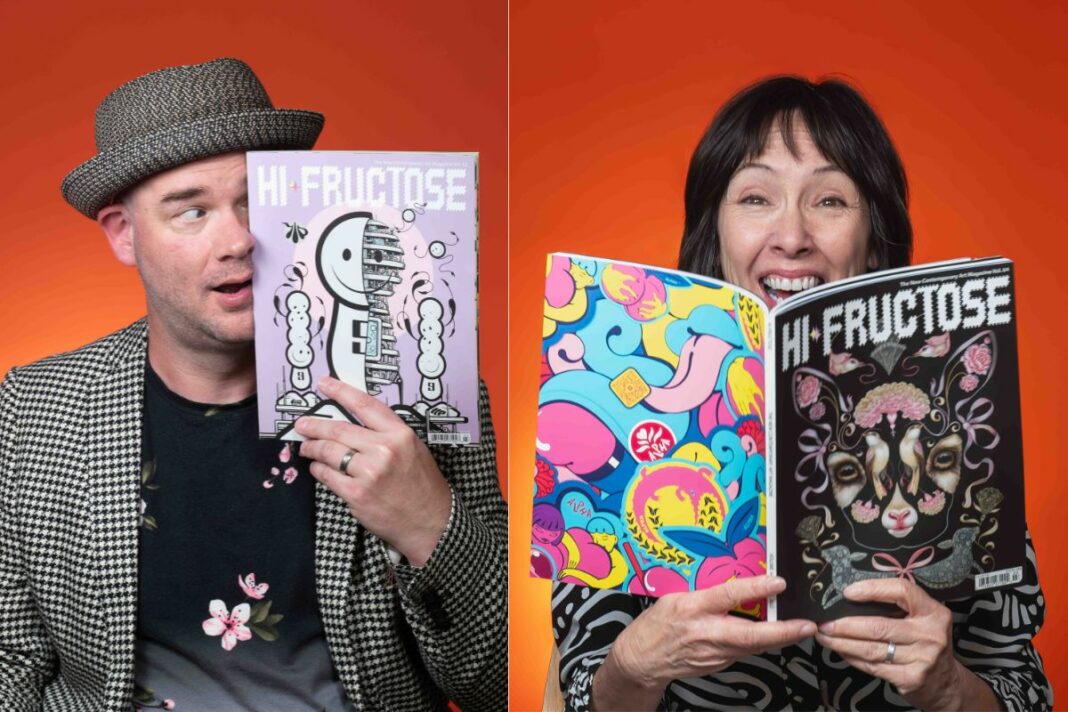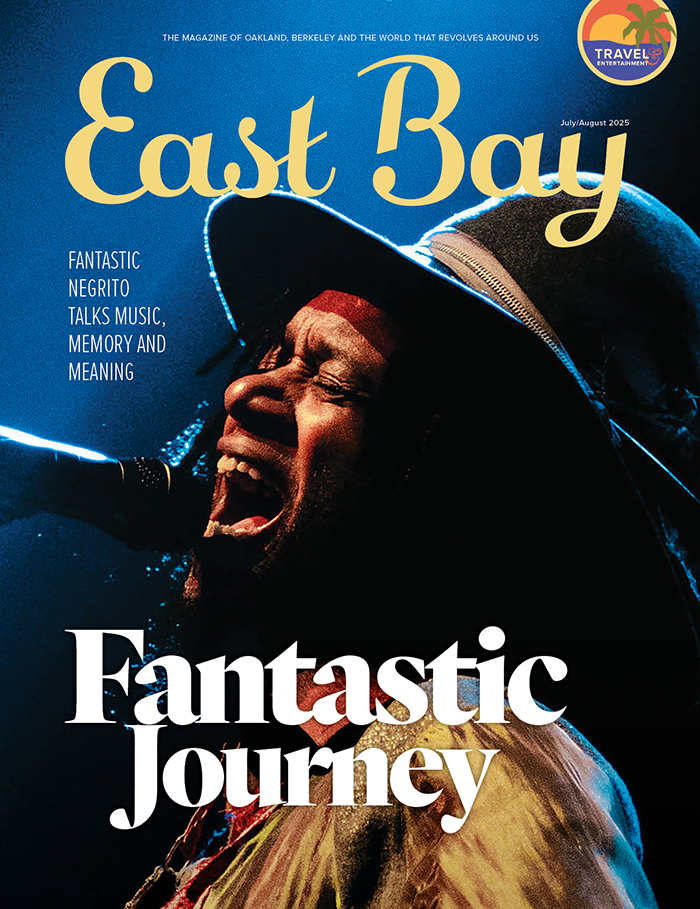The house on the corner of a quiet street in East Richmond doesn’t shout, “Artists within!” But during the pandemic, there was an event that may have given the game away.
Married artists Daniel “Atta Boy” Seifert and Annie Owens discovered that a giant agave in their front yard was undergoing its massive end-of-life bloom. Dubbing it “Timothy,” they created flyers inviting neighbors to walk or drive by and enjoy Timothy’s final exuberance. “We were just getting through each day at the time,” said Atta. “This was a way of seeing your neighborhood in a new way.”
People loved it. “I would be weeding, and they would stop and ask if they could take a selfie,” said Annie.
In some ways, the Timothy event says a lot about where both Atta and Annie are in their very individual art experiences. “In recent years, my art has become a form of therapy, especially after we had a serious car accident in 2021,” said Atta. “Very little is planned, and nothing is measured. I think art and play can be revolutionary for everyone; it can change the way that you respond to the world and how you operate in it.
“I seek to make work that inspires a sense of wonder, perhaps alters the narrative of one’s day and speaks to the possibility of possibilities…But most importantly, it gets me to the next day. In the end, even the art in the Louvre will burn up in the sun, no?” he added.
Although continuing to paint, Atta’s current focus is on sculptures created from recycled cardboard. A museum installation version of “The Upcycled Garden,” his vividly colored cardboard celebration of natural forms that was first seen at Oakland’s UMA Gallery, will be installed in St. Louis’ The City Museum in February. This version of “The Upcycled Garden” will combine both existing installations, and add larger works as well, using the recycling output of the institution.
Annie’s intricate, precise, mysterious watercolors, which use only black paint, have long reflected her interior journey, as well as her love of horror movies and ghost stories. “I never set out to illustrate my sense of isolation, displacement, or my thoughts and feelings, but stepping back, I can see that’s what came out,” she said. But now, “I’m ready to move on. I’m over swimming in Lake Me.”
“Lake Me” is, in fact, the title of one of the works that will be part of her solo show, opening Sept. 9 at Portland’s Brassworks Gallery. “I’m hoping with this show, the first in many years, to put the old themes of angst mostly behind me because, at this point, I’ve sorted most of that out,” she said.
Part of that sorting out happened as she built a self-described “little black witch house” on 17 remote acres in upstate California. When she sold it, she signed the underside of the porch.
Besides individual work, the two have a now-famous joint project. In October, Philadelphia’s Arch Enemy Arts will house an invitational exhibition of many of the artists who have appeared in Hi-Fructose magazine, launched by Atta and Annie in 2005, which has since become a sought-after art world publication.
Hi-Fructose “started as a dare while we were dating,” said Atta. “It was a bonkers thing to do, especially at a time when everyone was chanting ‘Print is dead,’” said Annie. The couple had been using the phrase, “New Contemporary Art,” for years, “which was just redundant and absurd enough to make a perfect blanket term for what we like to cover,” said Atta.
They were also motivated by not finding what they wanted to see in other art publications. “We used to go to bookstores, browse art magazines and come away with the sense that, in print, the focus was on either ‘blue chip art’ or ‘street art’ and not much else,” said Annie. “There was so much to be mined, and room for a new magazine that could embrace street art, blue chip, comic art, album cover art, artists you’ve never heard of next to legends…you name it, all in one place.”
Eighteen years later, Hi-Fructose has both an American and a European edition, is collected by its readers (“like National Geographic,” said Atta) and continues to defy classic marketing models. It’s still edited and put together primarily in the couple’s garage, which is also home to a vintage clothing rack, and a few stray upcycled “trees.”
It’s print-only, there are no advertorials, and “each issue is sort of a conversation between Annie and me, curation-wise. We battle it out, lobbying for different artists that either of us are inspired by or honestly often jealous of,” Atta said.
The Summer 2023 issue, for example, features art and artists ranging from the charming toy-like sculptures of Lesley Barnes and Ross McAuley, to the pioneering Afrofuturism of the late Rammellzee, to the hundreds of thousands of paintings by Brooklyn artist Steve Keene. “By now, we’ve learned that thinking differently from one another is a benefit rather than a challenge,” said Annie. “Most of the time, though, we’re thinking the exact same thing.”
Then there’s Game of Shrooms. Now an “international underground holiday,” held in June each year, it began in 2019 as a way for Atta to cope with depression. Recalling the mushroom ceramic pieces his grandmother created, he began hiding mushroom sculptures in public spaces, then challenging “hunters” on social media to find (and keep) them. The idea literally mushroomed.
It’s now celebrated around the world. “This year, one was hidden and found at the actual South Pole!” said Atta. “Tens of thousands of artworks have been shared with others in a commercial-free, extreme gift-giving way.” Annie helped formulate some of the game’s “Leave No Trace” rules, including “You don’t need to be destructive to be subversive.”
“The participants seem to really get it,” he said.
Atta’s work continues to draw attention and offers of collaboration from multiple places. Pre-pandemic, he and Annie traveled to Santa Fe to see the original Meow Wolf installation, “The House of Eternal Return.”
“We were skeptical about what they were doing initially, because of the fly-by-night ‘selfie museums’ that were proliferating at the time,” said Atta. But they were both entranced by the “mapless portals” of the building, and were given a tour of the factory space by one of Meow Wolf’s founders, the late Matt King, and director of artist collaboration Han Santana-Sayles.
“When I had a few ‘Garden’ installations under my belt, I sent a shout to Han,” said Atta. This resulted in a well-attended workshop at Meow Wolf’s Las Vegas installation, “Omega Mart,” with kids and artists using recycling materials from “Omega Mart.” He recalled, “The artists who helped me make a few pieces signed them with me.” Those pieces are now on display at Las Vegas’ Sahara West library, along with the original “Upcycled Garden.”
It’s impossible to know when, in the house on a quiet corner in East Richmond, which is filled with art made by other people, the next creative impulse or bonkers idea will emerge. The only certain thing is that it will—and then fantastically flower.












Atta and Annie are national treasures!
Agreed!